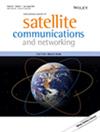超高频科学研究十年:揭开 Alphasat Q/V 波段卫星通信实验的神秘面纱
IF 1.6
4区 计算机科学
Q3 ENGINEERING, AEROSPACE
International Journal of Satellite Communications and Networking
Pub Date : 2024-07-25
DOI:10.1002/sat.1532
引用次数: 0
摘要
摘要2008 年,意大利航天局向欧洲航天局(欧空局)提议在 Alphasat 地球静止卫星上搭载一个 Q/V 波段实验有效载荷,从而巩固了其在极高频卫星通信研究和实验方面的地位。2013年发射的Alphasat大型平台因此承载了所谓的TDP#5(技术演示有效载荷),旨在执行首次Q/V波段电信和传播实验活动。由于对整个任务和科学目标的定义做出了宝贵贡献,该有效载荷随后被重新命名,以纪念超高频卫星传播科学研究的先驱阿尔多-帕拉博尼(Aldo Paraboni)教授。由于出色的科学成果和系统的高可靠性,实验活动仍在继续。拟议的电信实验的主要目的是证明 Q/V 波段宽带卫星通信的可行性,优化和空中 评估不可或缺的自适应传输技术的性能。此外,还在利用 Ka 波段以外频率的卫星系统框架内研究了与软件定义网络(SDN)和网络功能虚拟化(NFV)有关的创新范例的应用。使用超高频链路有助于减少射频前端,从而最大限度地减少轨道垃圾;此外,高吞吐量链路与软件驱动架构相结合,可实现高水平的系统可重构性,而这正是可持续利用空间的支柱之一。本文介绍了过去十年 Q/V 波段实验的主要成果,以及在可持续空间框架内未来科学和业务活动的计划和前景。本文章由计算机程序翻译,如有差异,请以英文原文为准。
A decade of EHF scientific research: Unveiling insights from Alphasat Q/V‐band satellite communication experiments
SummaryIn 2008, the Italian Space Agency (ASI) consolidated its position on research and experiments regarding extremely high frequency (EHF) satellite communication through the proposal to the European Space Agency (ESA) of hosting a Q/V‐band experimental payload on board the Alphasat geostationary satellite. The latter large platform, launched in 2013, thus hosted the so‐called TDP#5 (Technology Demonstration Payload), aimed at performing the first Q/V‐band telecommunication and propagation experimental campaigns. Thanks to the precious contribution given to the definition of the overall mission and the scientific objectives, the payload was then renamed in memory of Professor Aldo Paraboni, pioneer of scientific research on EHF satellite propagation.Since 2014, a large number of satellite communication scientific experiments have been conducted by the University of Rome Tor Vergata, principal investigator for the ASI telecommunication campaign. Due to the excellent scientific results and the high reliability of the system, the experimental campaign is still ongoing. The main objective of the proposed telecommunication experiments is to demonstrate the feasibility of broadband satellite communications in Q/V band, optimizing and assessing, over‐the‐air, the performance of the indispensable adaptive transmission techniques. Moreover, the application of innovative paradigms related to software‐defined networking (SDN) and network functions virtualization (NFV) has been investigated in the framework of satellite systems exploiting beyond Ka‐band frequencies.The goal that drives this experimental activity is to provide to the academic community, manufacturers, and service providers useful tools to cope with Q/V‐band links for future satellite communication systems. The use of EHF links contributes to the reduction of RF front end and thus minimization of orbital junk; moreover, high throughput links in conjunction with software‐driven architectures enable a high level of system reconfigurability that is one of the pillars for a sustainable use of space.The paper presents the main results of the last 10 years of Q/V‐band experiments, as well as the plans and perspectives for future scientific and operational activities in a sustainable space framework.
求助全文
通过发布文献求助,成功后即可免费获取论文全文。
去求助
来源期刊
CiteScore
4.10
自引率
5.90%
发文量
31
审稿时长
>12 weeks
期刊介绍:
The journal covers all aspects of the theory, practice and operation of satellite systems and networks. Papers must address some aspect of satellite systems or their applications. Topics covered include:
-Satellite communication and broadcast systems-
Satellite navigation and positioning systems-
Satellite networks and networking-
Hybrid systems-
Equipment-earth stations/terminals, payloads, launchers and components-
Description of new systems, operations and trials-
Planning and operations-
Performance analysis-
Interoperability-
Propagation and interference-
Enabling technologies-coding/modulation/signal processing, etc.-
Mobile/Broadcast/Navigation/fixed services-
Service provision, marketing, economics and business aspects-
Standards and regulation-
Network protocols

 求助内容:
求助内容: 应助结果提醒方式:
应助结果提醒方式:


